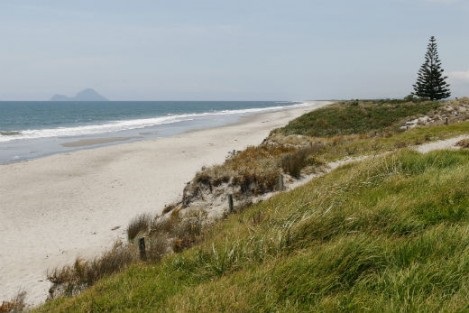Previously unsuspected volcanic action lifting up the Matata coast is the cause of a swarm of small earthquakes near Matata between 2004 and 2011, say scientists.
A combination of satellite images, GPS data and conventional survey information dating back to the 1950s shows that an area of land around Matata roughly 20km by 20km, about half of which is offshore, has been pushed up by about 40cm since 1950.
Volcanic activity is discovered under Matata. Picture: File.
Most of the quakes were between magnitude 2.0 and 4.0 and occurred at depths between 2km and 8km.
Until now the cause of the swarm was thought to be tectonic. The new finding concludes the swarm was caused by the growth of a previously unrecognised magma chamber under the Bay of Plenty coast.
During this period molten or semi-molten rock was being pushed up from below and caused land around Matata to uplift by about 1cm a year. As the magma moves in the sub-surface, it causes the surrounding rock to deform and break, resulting in small earthquakes.
Using modelling, scientists say a magma body lies about 9km below the surface. Since 1950, it has grown in volume by 0.2 cubic kilometres or equivalent in size to about 80,000 Olympic swimming pools.
Its presence does not mean an eruption might be imminent and it has not changed the volcanic hazard of the Bay of Plenty region.
The research is published in the journal Science Advances. It is titled 'Off-axis magmatism along a subaerial back-arc rift.'
Lead author Dr Ian Hamling, a satellite image specialist at GNS Science, says the finding highlights that accumulation of magma is not always where we might expect based on the location of volcanoes at the surface.
'Our modelling points to the presence of a magma chamber in an area where there has been no active volcanism for about 400,000 years,” says Ian.
Bodies of magma are reasonably common under large areas of the central North Island, and identifying another magma accumulation is not a huge surprise, says Ian.
"There is every possibility the magma body under the Bay of Plenty coast had been there for centuries, and possibly even longer."
To model the magma body at depth scientists used a combination of modern GPS data and conventional survey data dating from the 1950s. They augmented this with satellite radar data of the North Island, which has been collected from about 2003 onwards.
Observations of inflating magma bodies at depth are a reasonably common feature of volcanic areas worldwide, especially since the advent of highly accurate GPS and satellite measurements which can pick up small amounts of surface inflation and subsidence.
There are cases overseas where the surface inflation rate has been considerably faster than at the Bay of Plenty coast, but with no associated volcanic unrest, says Ian.
'While there is absolutely no evidence pointing to volcanic unrest in coastal Bay of Plenty, this finding underlines the fact that we live in a geologically active country where it pays to be prepared.”
He hopes funding will be available to continue this research so scientists can more accurately model the size and depth of the magma body, and keep a lookout for any changes that might occur at depth.
The authors of the science paper thank the European and Japanese Space Agencies for access to satellite images and GeoNet for the GPS data. The research was supported by public good research funding from the New Zealand Government, with additional support from the Natural Hazards Research Platform and Land Information New Zealand.
The Bay of Plenty, like the rest of New Zealand, is monitored by the EQC-funded GeoNet project which operates about 600 instruments nationwide. We could expect to get weeks, months, or even years of advance warning of any new volcanic activity.



3 comments
MMMMMM
Posted on 04-06-2016 07:42 | By peecee09
I thought my view had improved.
So
Posted on 04-06-2016 11:59 | By Capt_Kaveman
It could be possible this area could have another volcanic cone in the future and there is no reason why not but if so when 50-100yrs or longer, i thought with all that activity a new volcano wasnt out of my mind
@ peecee09
Posted on 04-06-2016 16:40 | By Crash test dummies
Your view will improve, when the new cone appears you will get a bot of elevation, that always assists with the view.
Leave a Comment
You must be logged in to make a comment.